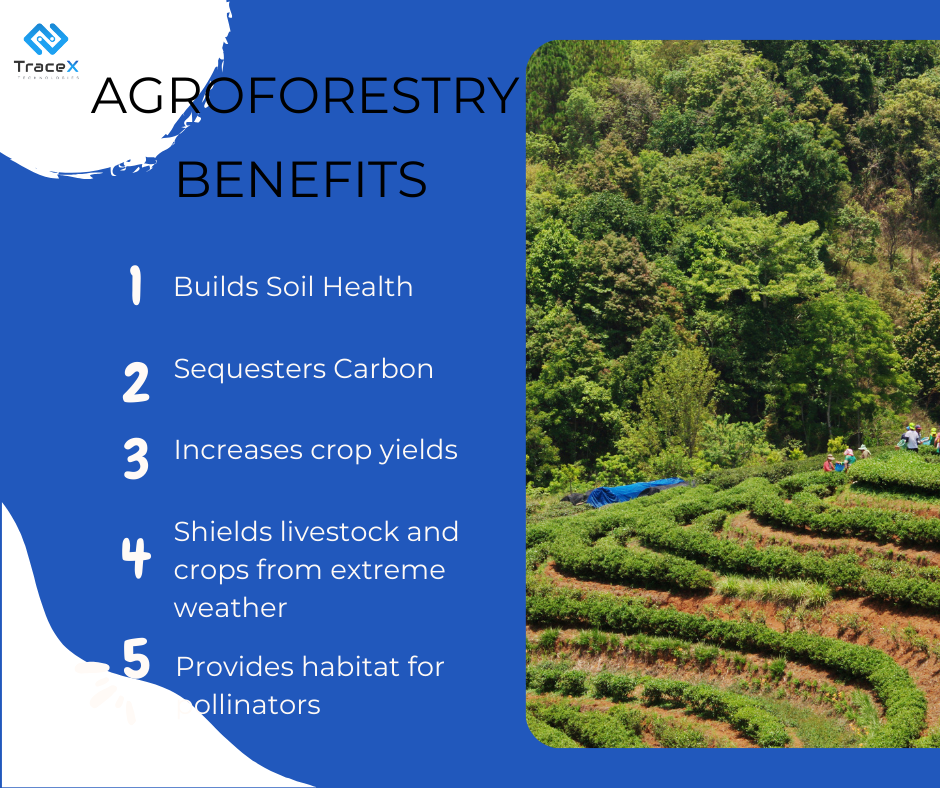Contact: +91 99725 24322 |
Menu
Menu
Quick summary: Dive into the transformative world of agroforestry within commodity supply chains. Explore the harmonious integration of trees and crops, unlocking sustainable practices in rubber, coffee, and cocoa production. Discover how this innovative approach not only enriches the agricultural landscape but also fosters biodiversity, resilience, and responsible resource management.

The integration of agroforestry is reshaping commodity supply chains and laying the foundation for a greener, more sustainable agricultural future. Agroforestry is a sustainable land management approach integrating trees and shrubs with crops or livestock. This synergistic system enhances biodiversity, improves soil fertility, and provides ecosystem services. The importance of agroforestry lies in its multifaceted contributions to sustainable agriculture. It fosters environmental resilience, mitigates climate change impacts, and promotes biodiversity conservation. Additionally, agroforestry systems enhance resource use efficiency, offering economic benefits to farmers.
Commodity supply chains represent the sequences of processes involved in producing, processing, and distributing goods. Understanding these chains is vital for sustainable agriculture as it enables traceability, quality control, and ethical practices, ensuring that commodities reach consumers in an environmentally responsible and socially equitable manner. Integrating agroforestry into these supply chains further reinforces sustainability by addressing ecological and economic aspects of agricultural production.
According to FAO, Agroforestry can increase soil organic matter, soil nitrogen, and carbon, which can increase the resilience of agricultural soils.
This blog delves into the transformative journey of harmonizing agroforestry with commodity supply chains, exploring how this synergy not only nurtures the environment but also yields economic and social benefits. From enhanced biodiversity to climate resilience, join us on a journey where agriculture meets ecology in a symphony of responsible and forward-thinking practices.
Agroforestry, a sustainable land-use system, is a practice that integrates trees and shrubs into traditional agricultural settings, fostering a harmonious relationship between crops and forested elements. Unlike conventional monoculture, agroforestry embraces a diverse and interconnected approach, strategically combining trees or woody perennials with crops or livestock. This intentional integration yields a range of ecological, economic, and social benefits. The trees contribute to improved soil health, water conservation, and enhanced biodiversity, while simultaneously providing additional income streams for farmers through the sustainable harvest of timber, fruits, or nuts. Agroforestry not only enriches the overall agroecosystem but also stands as a testament to sustainable land management, promoting resilience and longevity in agricultural practices.
Agroforestry plays a pivotal role in enhancing sustainability within the rubber, coffee, and cocoa supply chains. Agroforestry in rubber cultivation, integrating trees improves soil health, reduces erosion, and offers shade, promoting optimal rubber tree growth. For coffee and cocoa, agroforestry provides shade to delicate plants, fostering a microclimate conducive to their development. Additionally, diverse tree-crop interactions contribute to increased biodiversity, pest control, and enhanced pollination services. This not only improves overall yield but also ensures the resilience of these supply chains to environmental changes. The integration of agroforestry practices in these industries exemplifies a holistic approach, balancing economic productivity with environmental and social considerations.
The adoption of agroforestry practices in rubber, coffee, and cocoa supply chains represents a transformative approach to sustainable agriculture. In rubber cultivation, agroforestry introduces a harmonious blend of trees and crops, enhancing biodiversity, improving soil health, and contributing to climate resilience. Similarly, in coffee and cocoa production, agroforestry not only enriches the quality of the beans but also fosters ecological balance. The shade provided by diverse tree species benefits the delicate ecosystems these crops thrive in, while simultaneously offering economic advantages to farmers. This integrated approach underscores a commitment to responsible farming, where the synergy between agriculture and forestry contributes to both environmental conservation and the long-term viability of these crucial commodity supply chains.

Integrating agroforestry into commodity supply chains yields crucial environmental benefits.
By enhancing carbon sequestration and biodiversity, agroforestry not only contributes to environmental sustainability but also enhances the overall resilience of commodity supply chains.
Agroforestry’s integration into commodity supply chains brings forth significant social benefits.
Overall, the social advantages of agroforestry contribute to sustainable rural development by strengthening community bonds, improving livelihoods, and promoting shared responsibility for environmental stewardship.
Barriers to agroforestry adoption in supply chains include limited awareness, land tenure issues, and upfront investment challenges. Innovative solutions involve educating stakeholders about the benefits, promoting policy frameworks supporting agroforestry, and implementing financial mechanisms to ease initial costs. Best practices include collaborative efforts among farmers, industry players, and government bodies, encouraging shared responsibility. By addressing awareness gaps, policy constraints, and financial barriers, agroforestry can gain traction, offering sustainable solutions that enhance environmental, social, and economic dimensions within diverse supply chains.
Agroforestry emerges as a transformative and empowering practice, particularly for smallholder farmers who play a crucial role in global agriculture. For these farmers, agroforestry represents a holistic approach to land management, integrating trees and shrubs into their cultivated spaces. This method diversifies their income streams, enhances soil fertility, and provides resilience against climate variability. Smallholder farmers practicing agroforestry often witness improved crop yields, thanks to the protective canopy cover, while also benefiting from additional resources like fruits, nuts, and timber. Beyond economic gains, agroforestry encourages sustainable farming by promoting biodiversity and mitigating environmental degradation. It stands as a beacon of sustainable agricultural practices, empowering smallholder farmers to cultivate not just crops but also a resilient and thriving ecosystem.
TraceX DMRV (Digital Monitoring, Reporting and Verification) solutions play a pivotal role in revolutionizing the management of agroforestry projects within supply chains. With an emphasis on transparency and efficiency, TraceX enables real-time monitoring and verification of diverse elements in agroforestry, from tree planting initiatives to crop cultivation. This not only ensures compliance with sustainable practices but also enhances the overall resilience and productivity of agroforestry projects. By streamlining data collection, automating verification processes, and fostering traceability, TraceX empowers supply chain managers to orchestrate agroforestry initiatives seamlessly, thereby promoting environmental sustainability and responsible resource management within the agricultural landscape.
Emerging technologies in agroforestry are transforming sustainable land management. Remote sensing aids in monitoring tree growth and health, while precision agriculture optimizes resource use. Agroforestry is well-positioned to scale up in global supply chains given its adaptability and positive environmental impact. Companies embracing agroforestry can enhance supply chain resilience by mitigating climate risks and ensuring resource availability. Partnerships between technology firms and agribusinesses can further streamline implementation and monitoring. Recognizing the potential for improved yield, reduced environmental footprint, and enhanced socio-economic outcomes, the global adoption of agroforestry in supply chains holds promise for a more sustainable and resilient future in agriculture.
In conclusion, agroforestry stands as a transformative force within global supply chains, addressing environmental, social, and economic imperatives. By seamlessly integrating trees with traditional crops, agroforestry enhances sustainability, offering carbon sequestration, biodiversity conservation, and diversified income sources. Overcoming challenges through collaborative efforts among farmers, companies, and supportive government policies is essential for widespread adoption. The potential for scaling up agroforestry is reinforced by emerging technologies, allowing for precise monitoring and optimized resource use. As we navigate the complexities of modern agriculture, embracing agroforestry not only fosters resilient supply chains but also contributes to a more harmonious coexistence between human activities and the natural world, paving the way for a sustainable and inclusive agricultural future.
